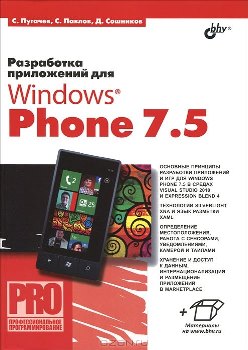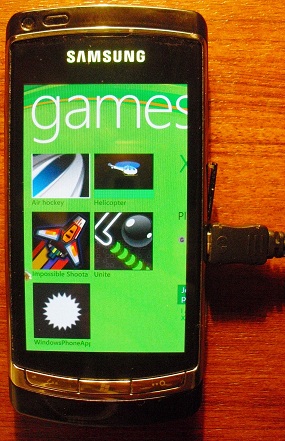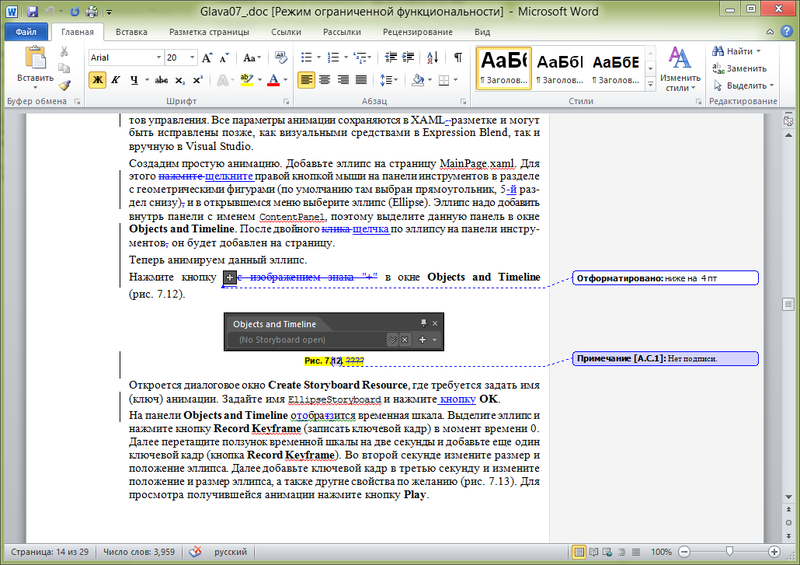We wrote a book! Practical experience publishing a book on programming

At the end of May 2012, the book “ Developing Applications for Windows Phone 7.5 ” was published, one of whose authors I am, Sergey Pugachev . For me, this book is the first experience of this kind, both of my co-authors - Stas Pavlov ( stasus ) and Dmitry Soshnikov ( shwars ) are the authors of other books.
Since after the book was published, I was periodically asked questions about how the writing process looked, how much time it took, about working with the publisher and other details, I decided that it would be better to write about this article and just give a link to everyone asking this kind of questions. In general, all, of course, from laziness.
This article is for me an attempt to understand the work done, and I hope that it will help someone decide to write their own book, because the feeling of euphoria that comes when you hold in your hands a newly published book with your name on the cover, or than incomparable!
')
This article consists of three sections, reflecting the three stages of the book writing process, namely:
- The idea of the book, negotiations with the publisher
- Writing a text book
- Work with the editor and edition
But before moving on to the first paragraph of the plan, I would like to dwell on one aspect that is directly related to the subject of the book.
Microsoft recently announced a new version of the Windows Phone operating system - Windows Phone 8 (WP8) .
Our book is dedicated to Windows Phone 7.5. In this case, Windows Phone 8 carries significant changes, both hardware and software platform. Is the book out of date? My answer is probably no. All applications written for Windows Phone 7.5 will work on Windows Phone 8. The knowledge gained from the book is applicable to the new version of the platform, of course there are differences, but on the whole the book will remain relevant for quite a long time.
1. The idea of the book, negotiations with the publisher
But let's start over. To be honest, I had a thought long enough to write a book some time ago, but this idea did not receive a concrete incarnation and I did not take any action for this. This thought lived on its own life in the "Maybe someday" section of my plans for the future.
I had an experience of writing texts and public speaking at the time of the beginning of work on the book. I write articles, speak at conferences, am a Microsoft MVP (Most Valuable Professional) for 4 years. Therefore, often, in large quantities, and with pleasure I talk about the development on the Microsoft platform, both in writing and orally. In addition, I conducted application development training on the ingloriously forgotten Silverlight platform.
Naturally, I had never written anything comparable in volume with the book. Diplomas protected at the university are not counted, since form is more important than content and, looking ahead, I will say that I did not spend 10% of that time on writing each of the diplomas (bachelor and master). writing a book.
But back to the beginning of the story. I was fascinated by the Windows Phone 7 platform since its very first announcement at the MIX conference in March 2010, where I attended personally (by the way, Internet Explorer 9 was announced at the conference, which changed everything for Silverlight developers, but then I haven’t knew). This conference was held in the United States in the glorious city of Las Vegas, and this was my first visit to the States. I remember how right after the planar conference report I went, through countless slot machines, to my room, which was located somewhere on the 30th floor of the Mandalay Bay hotel, from which a beautiful view of the runway at McCarran International Airport was opened. From the room, looking at the planes taking off, I began to download tools for developing applications for Windows Phone over a slow channel via Wi-Fi. To then install the downloaded SDK (Software Development Kit) on your modest Samsung NC10 netbook. The first version of the SDK worked terribly slowly (where a fair share of the blame lies on the netbook), but despite this, I fell in love with the platform from the first click, although I had never developed it for phones before.

At the MIX conference, everyone discussed Windows Phone only, although almost no one except real brazen people, including due to natural modesty, was allowed to touch any real devices. I received my own phone later, in the fall of 2010 in rainy Seattle at the PDC 2010 conference. Microsoft gave the phones to the conference participants for free, and after standing in a long queue I got a great Samsung Taylor. This phone was a prototype for developers and never officially sold. Probably, I became the first owner of a phone running the Windows Phone 7 operating system in Russia, not counting Microsoft employees.

I remember how in the evening before the PDC I sat in some Mexican eatery with Mikhail Chernomordikov ( mixen ), at that time working at Microsoft in the USA, and he asked what nomination to translate me as MVP: Silverlight or Windows Phone. I replied that in Silverlight, as this is a more general technology, and it was a huge mistake. The next day, Microsoft Vice President Bob Muglia said that the strategy has changed and Silverlight is no longer a priority for Microsoft ( Our strategy with Silverlight has shifted ), although we all refused to believe in it for a long time. Probably, if I became MVP on Windows Phone, the book would have been published much earlier.
Shortly before the PDC 2012, I began to publish in my blog a series of articles on the development of applications for Windows Phone. This cycle turned out to be incredibly popular, although, for various reasons, I abandoned his writing somewhere in the middle . The main problem was the lack of motivation, since it took a lot of time to write articles, and in connection with the new work it was sorely lacking. My next attempt to get a job at Microsoft on FTE (Full Time Employee) collapsed, and as a result, in the spring of 2011 I decided that I would not keep a blog about Windows Phone.
Toward summer 2011, it is time to defend a master’s degree. June 17, exactly one week before the diploma’s defense, when I was sitting with my supervisor, I wrote a deputy. chief editor of the publishing house BHV-Petersburg with a proposal to write a book about the development for Windows Phone. Apparently, he saw my blog and decided that I could write such a book.
I discussed this with the evangelists of Microsoft and Vladimir Kolesnikov suggested adding a part of game development to the book. Since I myself could not write such a part, we suggested that Dmitry Soshnikov become a co-author. He agreed, for which he thanks a lot! As a result, by August 2011, I wrote two chapters, but we did not reach the final contract with the publisher and decided to postpone writing the book for a while.
At this point, in addition to two chapters, the plan of the book was based on the beta version of Windows Phone 7.5, since the final version came out later. The plan was required by the publisher, and in any case it’s not worth starting a book without a plan.
Making a plan is quite a long process, it took me about a week or two. I looked through a lot of English-language books on Windows Phone, studied the materials, pondered ... In the future, the plan changed, but not very significantly. The plan presented a list of chapters with a fairly detailed description of what will be considered in these chapters.
In addition to the plan, I provided the publisher with a description of the book and texts like “why the book will be interesting to the reader”, as well as an estimate of the total number of pages (which eventually turned out to be quite close to the truth). I estimated the book at 350-400 pages and 20 chapters. The published book contains 384 pages and 21 chapters. Although the overall score for the number of pages was relatively correct, the estimate for the number of pages for each of the chapters was not completely justified.
The publisher, in turn, sent a template for Word, according to which the text should be designed. In addition, it was necessary to read the 26-page “manuscript requirements,” which described the rules for registration, naming, and other aspects of the requirements. There was nothing complicated about these requirements, and although I wrote the first chapters without taking them into account, it took about 15 minutes to format each chapter. Again, returning to the subject of diplomas, the requirements for them were an order of magnitude more complicated.
In September 2011, we suspended work on the book. As mentioned above, by that time two chapters had been written. At the end of December 2011, we came to an agreement on the book and agreed with Microsoft to purchase a certain number of copies that should have been distributed to the participants of the DevCon 12 conference in May 2012. In connection with this, a very tough deadline arose - the book had to be completely written by mid-March in order to complete editing and layout by mid-April, send it to print and distribute to participants at the DevCon conference on May 24, 2012.
Since I was planning to write a book (as it turned out later) exclusively in my spare time, it became clear that I could not manage to meet the deadline. I roughly represented the time needed to write a chapter, so it was obvious that I don’t have that much free time, and the chance to publish a book by May is almost zero.
The already mentioned Vladimir Kolesnikov, for which he is very grateful, suggested Stas Pavlov as a coauthor. Stas agreed, and thanks to this, the book eventually saw the light.
I must say that we did not write the book for the sake of money. And it's impossible to write a technical book for money. We wanted the price of the book to be minimal, and as many people as possible could buy it. Therefore, neither Dmitry nor Stas received a penny from this. I, in connection with a difficult financial situation, chose a monetary fee, the size of which is approximately equal to my salary for 2 working days.
So, we came to an agreement with the publisher, an agreement with Microsoft about buying a book, we had 3 co-authors and 2 written chapters. It was 2012, before the book was left in print, it took 3 and a half months.
2. Writing the text of the book
The main question that is being asked of me in connection with a book sounds like this: “How much time did it take to write?”. I'll try to count.
In the book, 21 chapter and application. Actually it is 22 chapters. I wrote 11 chapters and an appendix, that is, 12 chapters. Of these, 10 from January 1, 2012 to March 10. Thus, it took about 2 months for 10 chapters. I must say that not all chapters are the same size, there are very short chapters, there are long ones. The heads of Stas and Dmitry, for example, are all long, and I have several short ones.
I wrote throughout almost all New Year's holidays, from January 3 to 9. Somewhere around 4 (maybe a little more) hours a day. I would like to note an interesting fact that on the keyboard, on which I wrote almost half of the book, there are no Russian letters. But it is, by the way. In addition, I wrote almost every weekend about 3 hours a day, and also spent about an hour on weekdays.
In total, writing 10 chapters took about 120 hours. This is a month of work, if I wrote a book from Monday to Friday from 9 to 6. I must say that it is quite slow. Experienced authors say that you can write a technical book about twice as fast. But, we take the word for them.
In the process of writing a book, I often found myself thinking that I would never again enter into such an adventure. There was a feeling that the book would never be written, and indeed, given my tendency to depression, often the mood was just awful. But now, as time passes, the negative colors are erased, and I sometimes wonder: why not write another book? Although so far it turns out to drive away these thoughts successfully.
The most difficult thing in writing anything is to start. It happens, you walk for several days and you can’t write a single line, and then you sit down and write a whole chapter. If there is a first sentence, at least a few words, then it is much easier to write further. But sitting in front of an empty document in Word can be infinite. There were cases when I opened and closed an empty Word document several times.
In addition, it is difficult to start again after long (several days, a week) breaks. The ideal script is to write a little, but every day. In this mode, working on a book becomes much easier. But do not set unrealistic goals, for example, write a chapter a day. This only leads to frustration. Set a goal to write at least a couple of pages per day. As a result, often, it turns out, more, and this leads to a good mood.
When writing a book, I had a big problem - perfectionism. I really wanted to do everything perfectly. Therefore, I could re-read the chapter 10 times, change individual words, etc. But it really slowed down the work. As a result, I set myself a restriction - not to reread the written material in the process of writing more than two times. And it greatly accelerated the work. As a result, the editor pointed out the bad and incomprehensible places.
3. Work with the editor and edition
After I wrote my chapters, another important task arose. The book has three authors, they all write in a different style, using slightly different terminology and language turns. For example, the word “Notifications” in one chapter was translated as “Alerts”, and in the other as “Notifications”. And there were many such examples. The style of writing code examples also differed significantly between authors. In addition, occasionally there were repetitions between the heads of different authors, when in two chapters it was actually told about the same thing.
The reader also needs a holistic product. The book should be written in the same style and period. There can be no compromise. So I had to edit both my own and the heads of other authors.
After writing each chapter, I sent it to various familiar Windows Phone developers to express their opinions. The greatest help was provided by Kirill Orlov ( DiverOfDark ) and Sheriev Ahmed ( Atreides07 ), who pointed out a number of factual errors.
In the process of writing, we at some stage began to send chapters to the editor from the publisher. The editor is the most important person, perhaps even as important as the authors of the book. The editor made the language more literary, and also corrected a lot of errors, including actual, as well as terminological, and even a few errors in the source code.
Working with the editor looked like this: I sent the head to the editor, she returned it with her edits and questions. I commented on the edits and answered questions, possibly correcting the text of the chapter itself. After that, I again sent the head to the editor, and the cycle was repeated. Usually one time was enough, but some chapters walked back and forth 2-3 times.

On preliminary editing and work with the editor took about 2 hours per chapter. Total, actually one more full working week.
Also, some time was spent on the design of an archive of examples of source codes. But I designed the source code in parallel with the writing of chapters, so a lot of time for code samples did not go away.
April came, I successfully and the first time passed the exam in the traffic police, and the book was almost ready. When all the chapters were edited, the text was sent to the layout, and a month later I was holding a freshly printed copy of the book.
When I arrived at the DevCon 12 conference, went to the office space, unpacked one of the boxes with books and picked up a copy - it was then that real happiness came and a feeling of joy from the work done.
The next day, a copy of the book was distributed to all conference participants, and I signed an autograph many times. People came up and asked to sign, and it was really great!

So in the Noginsk district of Moscow region, where the DevCon 12 conference took place, the story that began in distant Las Vegas in April 2010 ended.
So far we have not discussed this, but perhaps we will adapt the book to the new version of Windows Phone - Windows Phone 8. Therefore, the story does not really end there.
Thanks to everyone who helped write the book!
Source: https://habr.com/ru/post/146613/
All Articles